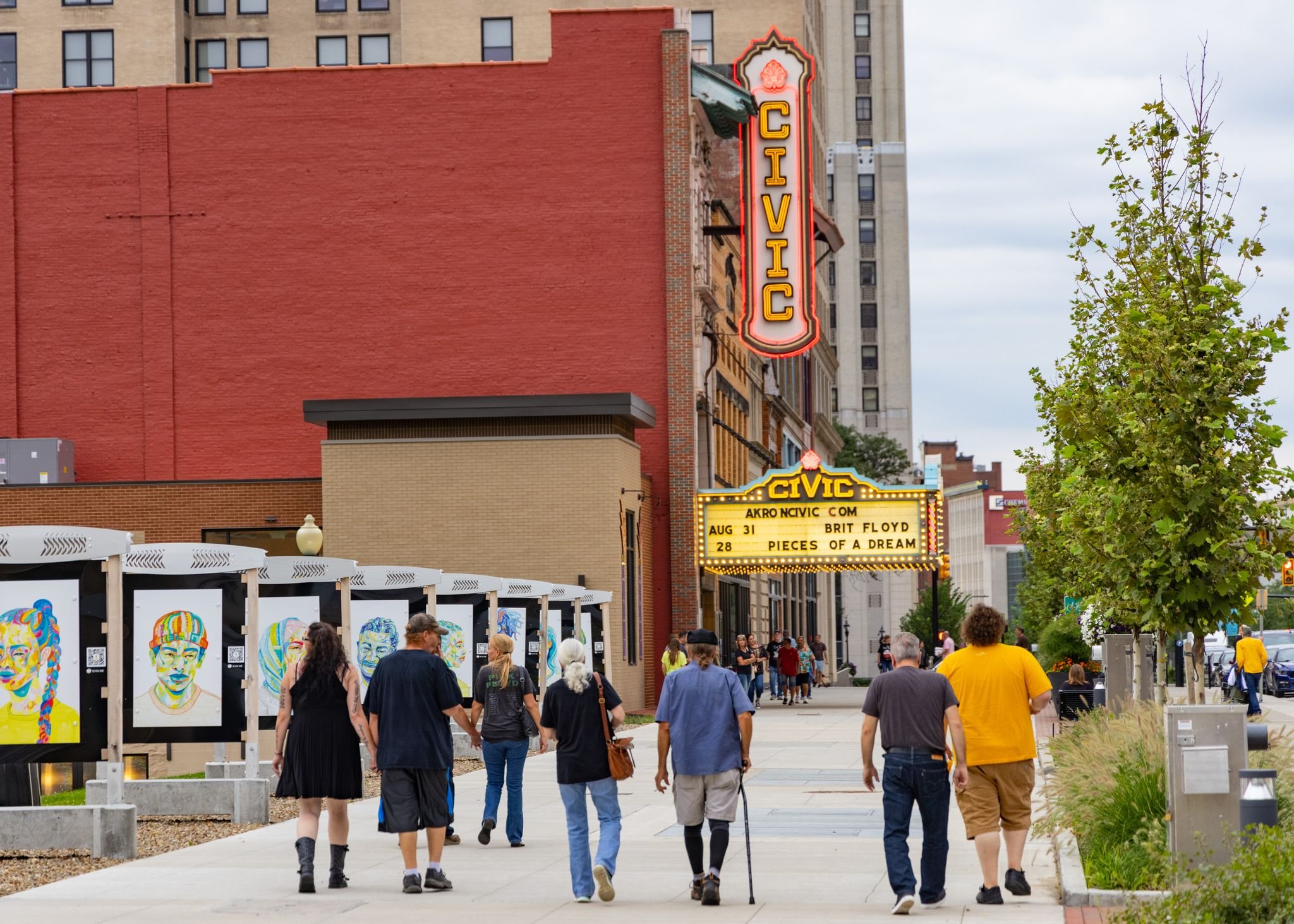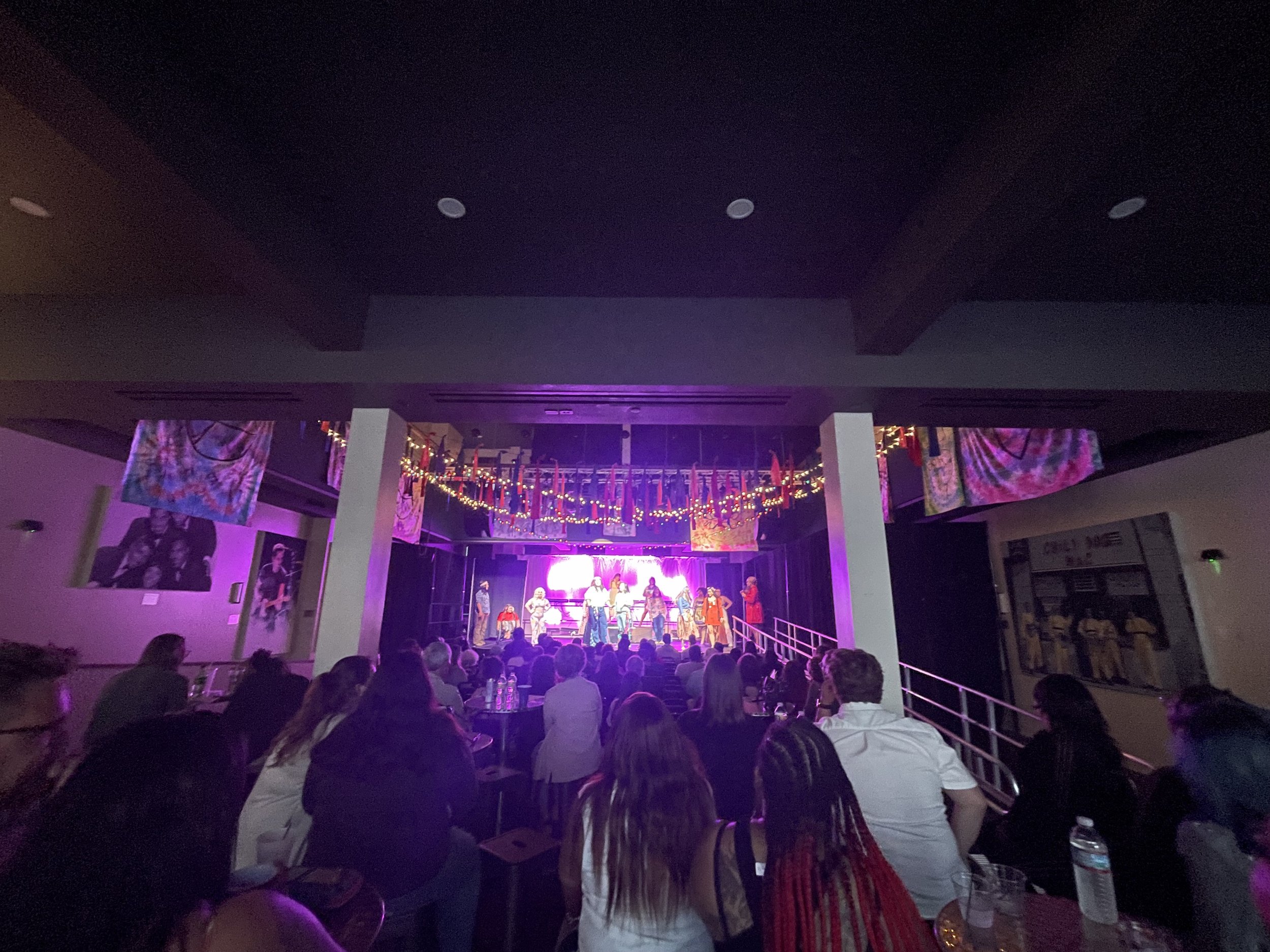The Bowery District Brings New Residences, Restaurants, and Storefronts to Akron Civic Commons Footprint
Sometimes a truly visionary project needs to delve deeply and thoughtfully into the past. In order to revive and rehabilitate six historic buildings in a formerly blighted city block along downtown Akron’s South Main Street and West Bowery Street, developers and city visionaries had to look past the crumbling cinder block and reflect on what the neighborhood would have looked like at the turn of the century: a thriving main street where people lived, shopped, dined, worked, played and enjoyed walking to everything they needed along a scenic strip of waterfront.
In 2020, The Bowery District was unveiled. This $42 million restoration project includes 92 luxury apartments, and 40,000 square feet of retail and office space, including a restaurant and theater. It’s anchored at the corner of the block by the architecturally impressive 12-story Landmark Building, which was built in 1923, and originally housed the Akron Savings and Loan Company.
Kimberly Beckett, who is director of business relations and development for the Downtown Akron Partnership, says bringing people back to live in the downtown area and providing a rich experience in the arenas of the arts, culture, shopping and office spaces is what makes The Bowery District such a dynamic neighborhood.
“Before Lock 3 opened in 2003, the downtown didn’t really have many welcoming spaces for people in the community to engage in,” she says. “What makes The Bowery District so special is that it adds desirable living and recreational spaces, while keeping the colorful historical character of our city alive.”
The panoramic views afforded from the buildings are in keeping with the fresh energy of the urban landscape, particularly the adjacent park surrounding the waterfalls of Locks 3 and 4 concert and event arenas. Over the years, the Akron Civic Commons has added enhancements such as colorful LED lighting, seating and lush landscaping to make these public spaces even more inviting.
Revival at its Finest
The Landmark Building’s new luxurious living spaces take a nod from the past with soaring floor-to-ceiling windows that lend sweeping sights of the city. And just like back in the 1920s, today residents enjoy walking wherever they need to, whether that means the entertainment district, Locks 3 and 4, coffee shops, boutiques, fine dining and even easy access to the Ohio & Erie Canal Towpath Trail. Local hot spots within close proximity include the Akron Art Museum, Canal Park, Home of the Akron RubberDucks, the Akron Zoo, John S. Knight Center and the University of Akron, and the Akron Civic Theatre.
Nestled within the first floor of the building lies the equally iconic restaurant Crave, which serves eclectic, globally-influenced fare. It moved from its previous location, where it was open for nearly 17 years, to here and opened in the summer of 2022.
Crave owners Aaron and Dana Hervey took a chance in moving into the new district. They have a keen appreciation for the history of its 8,000 square feet of space that seats more than 300 people, with two-story windows and ornate ceilings.
A first-floor bar made from porcelain and stainless steel features two stunning modern sculptures by Akron artist John Comunale rising from the back bar to the second story mezzanine.
The rear of the restaurant is a retail wine shop, and behind an adjacent wall, a grab-and-go market serves some of the restaurant’s to-go specialties, so convenient for the building’s tenants. In spring, summer and fall, front sidewalk patio dining offers some of the best people-watching perches in the city.
Bringing Back the Golden Age of Theater
One of the shining jewels of The Bowery District is the restoration of the majestic Akron Civic Theatre.
Development teams completely restored the arcade and grand lobby. Opened in 1929 and listed in the National Register of Historic Places, the Civic was originally named the Akron Loew’s Theater. Erected at a cost of more than $1 million, today it remains one of only five atmospheric theatres in the United States designed by well-known architect John Eberson, one of the foremost theater designers of the 1920s. It’s a true representation of the golden age of the American movie palace. A hallmark design of Eberson’s, the atmospheric style is meant to evoke the sense of being transported to an exotic outdoor location, with patrons sitting in the theater experiencing a projected star-lit sky and clouds slowly moving across the horizon.
In the past, the stage was graced by memorable movies, and famous entertainers such as Mickey Rooney and Tim Conway, as well as musicians including Louis Armstrong, Robert Goulet, Devo, The Pretenders and The Black Keys.
The breathtaking space’s grand staircase, Italianesque statues, murals, chandeliers and decorative details, which were designed to emulate an outdoor garden, were all painstakingly restored to their original grandeur.
The grand reopening of the theater took place in August of 2021.
Howard Parr, who is executive director of the theater, says the large-scale $8.5 million restoration has re-energized and repurposed the district into an exciting cultural destination.
In addition to bringing the 2,500-seat main theater back to life, the project included the construction of the 220-seat John S., James L. and Clara Knight Stage in the adjacent Whitelaw Building. Original fixtures were salvaged and modern design, acoustics and lighting were added.
In May 2022, Welty Building Company, which was responsible for the work, was recognized with the Award of Excellence for the Preservation of a Cultural Landmark to Knight Stage at the Civic and Grand Lobby Restoration of the Akron Civic Theater.
The facility now hosts shows, musicals, jazz and blues festivals, comedy nights and even outdoor happy hours under the marquee in the summertime.
Kyle Kutuchief, program director for the Knight Foundation, says his organization was proud to commit $4 million to create Knight Stage.
“The project not only converted a vacant building on Main Street into a vibrant mixed-use block—it made people believe that downtown Akron can be a neighborhood again,” he says. “In 2019, the core of the city had about 450 market rate apartments. The Bowery was the first mover to demonstrate that pent-up demand is real. Today, there are over 1,000 new units either complete or under construction across seven different projects. These conditions were made possible by The Bowery.”
According to Parr, “The Knight Stage has exceeded all of our expectations, allowing us to host the most diverse schedule of programming in the theater’s history. It, along with the restored main auditorium and Wild Oscar’s, our new micro-performance space at Lock 4, makes it possible for The Civic to offer the kind of critical mass of programming we all know is so important to a vibrant downtown.”
Don Taylor, who is president and CEO of Welty Building Company, says, “It’s also helped create a livable, walkable and workable downtown district all while preserving the historic details of the building.”
An Eye to the Future
As soon as The Bowery opened, it spurred renewed interest in residents moving downtown. According to Bowery Property Manager Joe Taylor, the building is currently at 97% capacity, with only two units available.
In a true “build it and they will come” fashion, the district has fostered further growth and redevelopment in prime real estate in the center of town. In fact, according to a study by the University of Akron and Kent State, it’s predicted that over the next five years, the district will generate more than $113 million and 850 jobs in Summit County.
Already in the works is the museum-quality Akron History Center, slated to open in 2023. It is expected to take up 3,000 square feet of exhibit space over three floors in Building D, the circulation building, with access from Main Street to Lock 4.
“We are extremely happy to be leading the revitalization of downtown Akron, bringing residents back to the city,” says Joe Taylor.
What turns once-forgotten structures from the past into a successful downtown district hub?
From someone who has been involved in the ambitious urban rehabilitation from beginning to end, perhaps Kyle Kutuchief sums it up best when he marvels at where the formerly decaying city block is today: “a thriving destination in the center of the city where people can live, enjoy the arts and go for some of the best food and beverages in town.”
To learn more about The Bowery District, visit BoweryDistrict.com.


